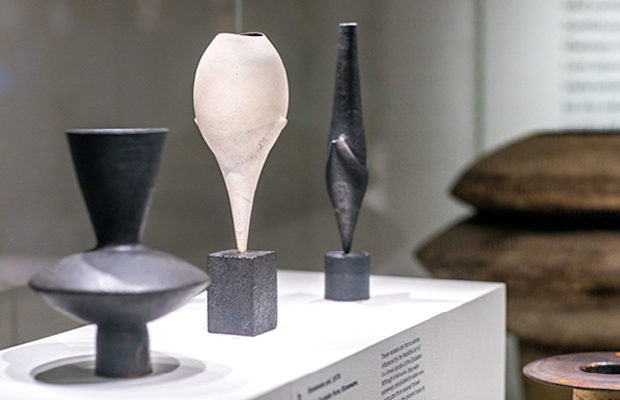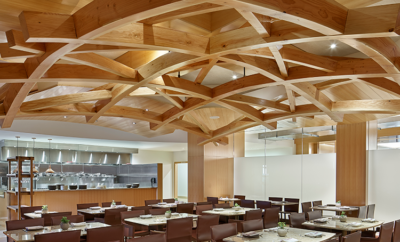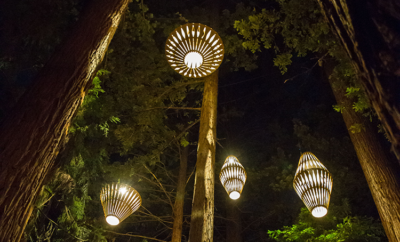
Exhibition
Shaping Ceramics: The Creative Force of Postwar Refugees in England
Looking at Lucie Rie’s press-molded buttons showcased in Shaping Ceramics: From Lucie Rie to Edmund de Waal at the Jewish Museum in London—elegant flowers, knots, stars, and raised cups, glazed in brown and cream, ceramic gold, turquoise, or coral red—you can’t help but think about the stubborn durability of fine objects. Such small things, easily picked up and carried about, might be seen as metaphors for lives dispersed and reassembled because of accidents or tragedies of politics. The buttons, after all, were made in the 1940s, and the exhibit honors the diaspora of extraordinary Jewish refugees who, like Rie, came to England, as well as paying homage to subsequent generations of Jewish artists who have had a remarkable influence on British ceramics.
While most of the work in the show was made in Great Britain, the earliest pieces were designed by Grete Loebenstein, later known as Grete or Margarete Marks, and produced at Hael-Werkstätten, the factory near Berlin which she and her first husband owned and managed. Her Bauhaus-inspired tableware, geometrically shaped and colored in vibrant, contrasting glazes—uranium red and green at the breaks or black with lemon-yellow interiors—was deemed degenerate during the Nazi period when she was forced to sell her factory at a great loss before emigrating to England in 1936. It’s rare to find Marks’s pieces on exhibit and a pleasure to have the opportunity to see her spherical teapot with its whimsical, cone-shaped spout and double-looped handle, or her earthenware plate with its Wassily Kandinsky-like decoration of circles, dots, and lines.
Marks brought Bauhaus concepts onto British soil, but Lucie Rie, who was born in Vienna and immigrated to England in 1938, was a living link to the Wiener Werkstatte since she had studied ceramics at the Kunstgewerbeschule where Josef Hoffman was principal. Her crisp, eggshell-thin vessels—pleated, furrowed, or incised with sgraffito—challenged the prevailing style of utilitarian craftsmanship. Among the pieces on display, her pink, tall-footed porcelain bowl, with its painted thin turquoise stripe and bronze-colored bands, fans open like the mouth of a flower. The glaze running down its sides demonstrates the sublime effects of unexpected chance.
In 1946, when he was in his mid-twenties, Hans Coper began assisting Rie in her studio. Coper had escaped Germany only to be arrested in England as an enemy alien and interned in Canada. After his release, he joined the non-combatant corps as a conscientious objector. When he came to Rie, he had no experience making pottery. He worked with her for twelve years as a partner and friend before going on to establish his own studio. Over the years Coper developed a series of core shapes—spades, discs, thistles, and Cycladic forms. The exhibition includes an array of his stoneware pieces—some with burnished surfaces, others blackened or abraded so they appear like statuary stamped by time.
The exhibition catalogue includes a charming interview with Ray Silverman, now in his seventies, who came to study with Rie and Coper by accident when he was a twelve-year-old boy at the Camberwell School. He speaks about the integrity of his teachers and their high standards, “…even today if I finish a piece…I immediately think, ‘what would Lucie say?’” You can see the familial relationship in his rust-colored stoneware vase with concentric rings at the flattened rim or the pristine symmetry of his swollen white porcelain bottle with the fine opening of its stemmed mouth.
Several of the other ceramicists were influenced by the sculptural quality of Coper’s work. Ruth Duckworth is best known for her organic and surreal, hand-built porcelain forms or panels finished with transparent glaze, but here she’s represented by a spritely footed bowl with ragged surfaces painted in earth tones. Janet Haig makes both hand-built pots with oxides, slips, and glazes that tend to turn into abstract landscapes and torsos that appear corroded or weathered like gravestones covered in moss. Antonia Salmon’s polished and smoke-fired abstract pieces are reminiscent of the stately and classical forms created by Barbara Hepworth.
The two youngest artists in the exhibition have taken the medium in diametrically opposing directions. Edmund de Waal is both a potter and an installation artist, and his free-standing Arcady (2007) is composed of eighteen similarly shaped and stacked ceramic vessels, colored in six celadon glazes in various shades of white, yellow, and cream. Placed inside a steel box with a cutout opening, the pots are part of a work that’s both minimalist and symbolic, incorporating ideas about visual intervals and hidden beauty. David Breuer-Weil’s Emergence is a work of narrative sculpture, telling the story of the first man literally coming out of the earth, first as the lump of his head and growing progressively larger in six subsequent stages. Cast in bronze with roughened surface skin, pinched, incised, and imprinted with squiggles and words, the piece is expressionistic and reminiscent of Jacob Epstein, a much earlier British and Jewish master of clay. In this way, the show runs the gamut, presenting the abstraction of the potter’s vessel as well as the vessel that is man. jewishmuseum.org.uk

Grete Marks, Teapot. Courtesy of The Potteries Museum & Art Gallery, Stoke-on-Trent.












